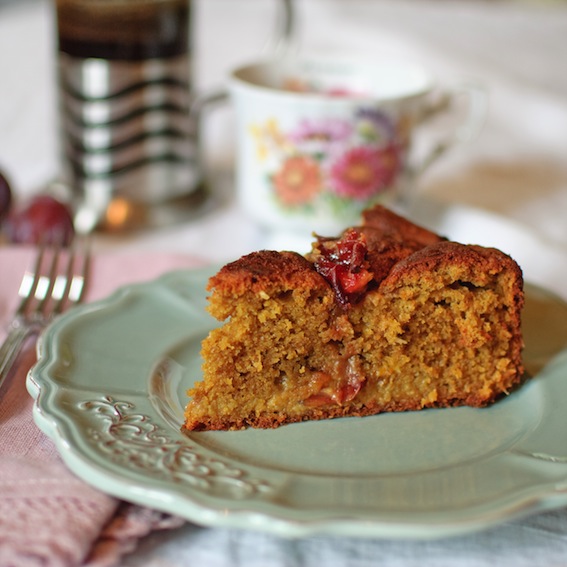-
Double chocolate and spicy pear muffins and equine sleepovers
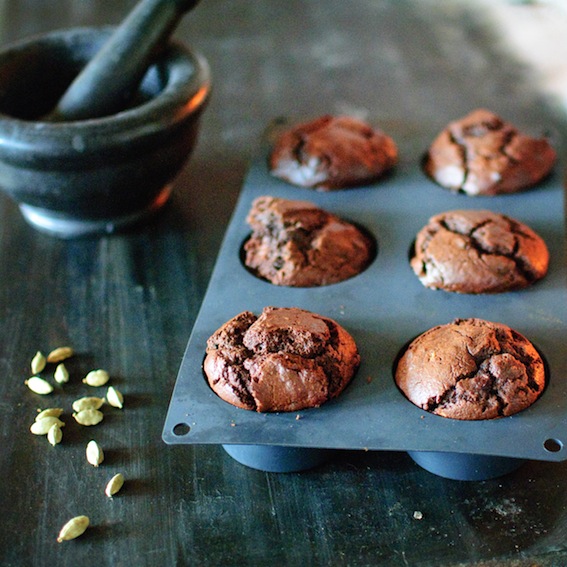
Two of our horses went for a sleepover last night. Castaño, our youngest horse, goes for private tuition every Monday at a nearby School for Extraordinarily Naughty Horses. The school is very recent; I’m convinced its creation was motivated by the mass of potential clients amongst our wayward equines. We received a phone call from Castaño’s teacher at 11pm, asking whether we had lost anything. After establishing that, unfortunately for me, she hadn’t found my sunglasses, she said that she did have our two bay horses. It was decided they stay overnight, which thankfully avoided us a precarious and muddy moonlit traipse. When I went to fetch them this morning, it occurred to me that maybe Castaño had been trying to win brownie points by turning up early for his weekly lesson and had taken Texas, the wise 30-year-old, to show him the place where he was learning to become A Better Horse. I think we can safely say this particular project is still very much ‘work in progress’…


These muffins are a really rich double chocolate treat. Just in case you’re looking for an excuse to make them, both cardamon and dark chocolate increase serotonin levels in the brain. Amongst other things, serotonin helps ward off depression. And who doesn’t need a serotonin boost towards the end of the winter?
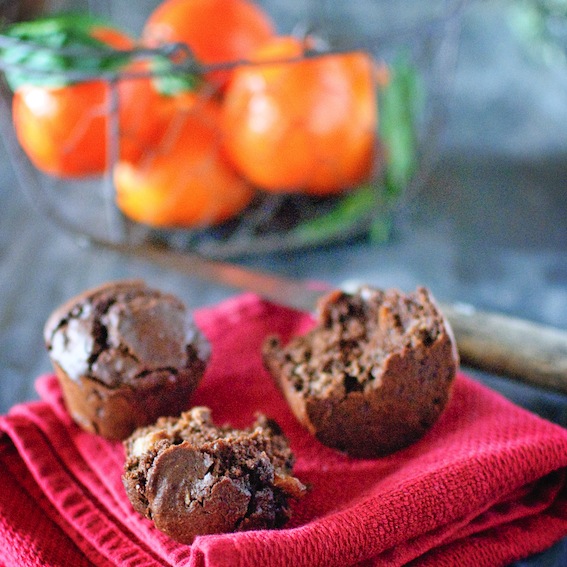
Ingredients (makes 12)
275g spelt flour
50g pure cacao powder (no added sugar)
2 teaspoons baking powder
1 teaspoon bicarbonate of soda
1 teaspoon cardamon
½ teaspoon ginger, freshly grated
3 eggs
250ml coconut milk
4 tablespoons honey
1 pear, peeled and chopped into small cubes
150g organic virgin coconut oil, melted
100g 70% dark chocolate, melted
Preheat the oven to 180°C. Prepare and grease two muffin tins with butter or coconut oil. Sift the flour, cocoa powder, baking powder, bicarbonate of soda, cardamon and ginger into a large mixing bowl and set aside. In a separate bowl, beat the eggs and then add the coconut milk, honey, pear, melted coconut oil and chocolate, stirring constantly. Combine the two mixtures well. Fill the muffin tins and bake for about 18 minutes.
Absolutely delicious served hot or cold! -
French custard tart (Far Breton) and discombobulated headmasters

Yesterday afternoon, equipped with wetsuit and flippers (I won’t harp on about the weather — let’s just say that we’re in no imminent danger of drought), I sailed through white water torrents to fetch Léo. Upon arrival in front of the school, the car, possibly rebelling at being mistaken for a catamaran, spluttered and died. I had to comandeer several classmates and their mothers to help move the catamaran/car out of the way, the aim being that we would push while Léo steered to a less hazardous spot. So much for my theory; what actually happened is that he somehow managed to jump start the wretched thing, leaving us ‘pushers’ face-down in a puddle, our arms stretched out in front of us. I thought it probably best to avoid convoluted explanations with the headmaster who was looking, quite frankly, more than a little bewildered by the sight of one of his eleven-year-old pupils driving around the school car park with his squealing, hand-flapping, mud-speckled mother in wet pursuit…

This ‘Breton Far’ originated in Brittany in the 18th century, when it was served as a savoury accompaniment made with buckwheat flour. Today it has become a traditional dessert and is often filled with dried fruit such as raisins or prunes. The sweet version is usually now made with plain flour and white sugar, but I have made my own version, which is just as good, if not better and certainly far healthier. The combination of whole flours, eggs and honey makes for a low GI dessert.
If you replace sugar with honey in a recipe you should halve the quantity as honey has double the sweetening power. Because honey is metabolised differently from sugar in the body and, as such, does not cause insulin spikes, it can be enjoyed in moderation without any of the downsides of other sweeteners and all of the upsides of eating honey. You should also slightly lower the cooking temperature when cooking with honey as it ‘browns’ more quickly than sugar.
Ingredients (serves 6-8)
60g buckwheat flour
60g whole spelt flour
4 free-range eggs, beaten
65g honey
1 teaspoon vanilla extract
2 tablespoons rum (optional)
500ml organic milk
120g dried, stoned prunes
Grease a rectangular oven-proof dish (roughly 22cm) and preheat the oven to 180°C. Pour the eggs, honey, vanilla, rum and flours into a large mixing bowl and beat well for about five minutes. Add the milk and beat for a a few minutes more. Garnish the bottom of the dish with the prunes and then pour in the mixture. Bake for about 40 minutes, or until the mixture is no longer runny (or squelchy!). You may have to pierce the ‘skin’ after about 30 minutes. Best served chilled.
-
Spice bread and watching a white hen unravel
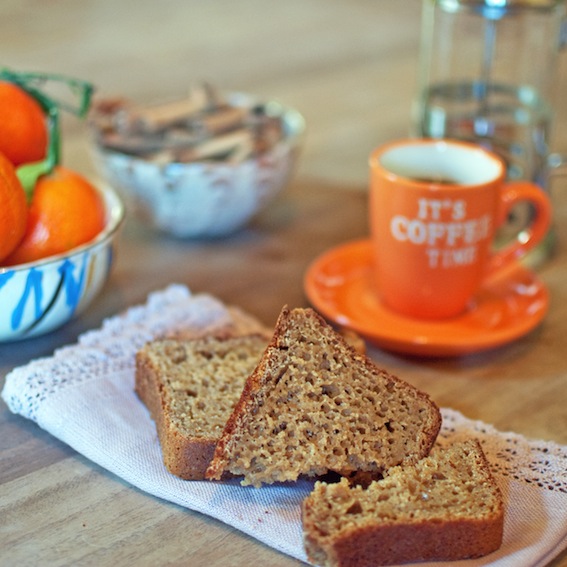
Have you ever seen a hen unravel? I hadn’t, but I have now. A friend (I use the term loosely in hindsight) gave us four hens last week. When I say hens, obviously I mean butch, feathered, street-wise ladettes hell-bent on stealing the others’ food, staying up all night and generally causing mayhen (sorry!). Our white ‘head’ hen was not amused by their arrival and ‘greeted’ them with firmly-closed wings. As soon as she caught sight of them, she strutted purposefully over to the kitchen, squawking loudly until I opened the window. When I explained that it was OK, they had been invited, she wandered off for a mad, muttering walk on her own in the woods, head between wings. Even now, a week later, she comes to check with me everyday that these ruffians are still welcome and spends more time than usual on her perch, disdainfully looking down at them.

This spice bread is deliciously soothing, which is useful when you’re trying to console a hen with a grievance.
Ingredients
500g raw honey
250g spelt flour
2 teaspoons active dry yeast
½ teaspoon cinnamon
½ teaspoon ginger
½ teaspoon nutmeg
½ teaspoon coriander
½ teaspoon cardammon seeds
Zest of 1 lemon
2 free-range eggs, beaten
100ml milk
Preheat the oven to 220°C. Dissolve the yeast in two tablespoons of lukewarm water and set aside. Gently warm the honey, spices and zest until very runny (about 3 minutes). Place the flour in a mixing bowl, leaving a well in the middle. Add the yeast and then the beaten eggs and milk to the well, followed by the honey and spice mixture. Beat until you obtain a smooth, liquid dough. Transfer to a 1kg greased loaf tin and cook for 1 hour 15 mins. Cover the tin with aluminium foil once it is golden brown. It is best to leave the bread in a tin to rest at room temperature for at least three days before eating. -
Spelt yule log (bûche de Noel) and an unidentified thigh thief
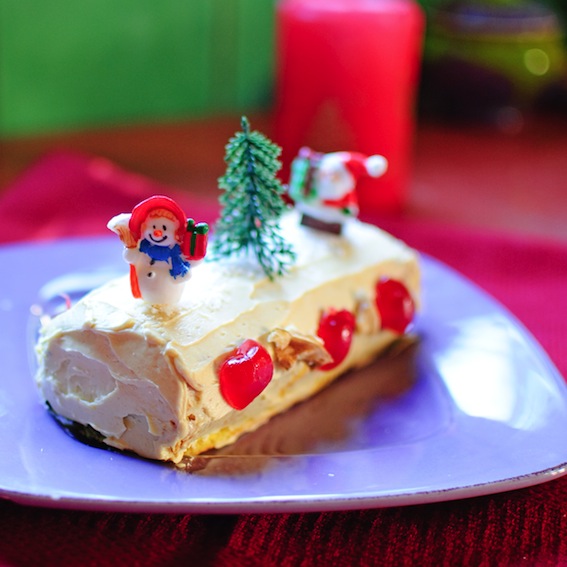
I can’t believe I’m admitting to this, but our Christmas lunch was stolen by an unidentified creature. We had put the guinea fowl, which had been slaughtered, plucked and frozen by our neighbour in November, to defrost on top of a very tall fridge in the grange. At the time, it was the proud owner of two wings and two thighs. Anyway, bad plan because when I went to get it the next morning it was minus a thigh. As we don’t have a cat, I can’t imagine what sort of animal could have climbed a slippery surface that high; it definitely wasn’t Hugo because he suffers from vertigo. My money’s on a carnivorous giraffe. Admittedly there aren’t many in Southwestern France, but it’s the only thing that makes sense. Luc, my husband, was all for cooking and serving it as an amputee delicacy, claiming that the cooking process would kill any lingering giraffe germs, but I put my foot down and we located a beautifully intact capon in a shop in the village, conveniently open on the 25th December no doubt in case of such incidents.
This ‘bûche de Noel’, which is similar to a roulade, is the traditional French Christmas dessert. It should be kept under lock and key IN THE HOUSE until you’re ready to eat it!
For the sponge:
Ingredients
4 free-range eggs
180g cane sugar
1 teaspoon vanilla extract
160g spelt flour
1 teaspoon baking powder
Raspberry jam to fill
Preheat the oven to 200°C and prepare a Swiss roll tin by lightly greasing and lining the base and sides with a large sheet of greaseproof paper, pushing it into the corners. Beat the eggs, vanilla extract and sugar together until thick and creamy and then add the spelt flour and baking powder, incorporating well. Spoon the mixture into the tin and bake in the preheated oven for nine minutes. Once baked, remove from the oven and immediately roll into a spiral on a floured-surface. Unroll and spread generously with raspberry jam. Roll again and set aside.
For the butterceam icing:
Ingredients
125g butter, softened
60g cane sugar
2 egg yolks
2 teaspoons of coffee powder, diluted in two teaspoons of water
Pour the sugar into a saucepan, lightly moisten with a few drops of water and cook for about six minutes, stirring constantly. Stop just before the mixture caramelises. Beat the egg yolks and add the hot sugar little by little until the mixture whitens. Beat the butter well and gradually add the egg yolk/sugar mixture. Finally, add the coffee, incorporating well. Cover the rolled cake with the buttercream, spreading with a spatula, decorate with walnuts and glazed cherries and leave to cool for at least an hour in the fridge before serving. -
Rum and raisin carrot cake (gf) and frustrated traffic wardens
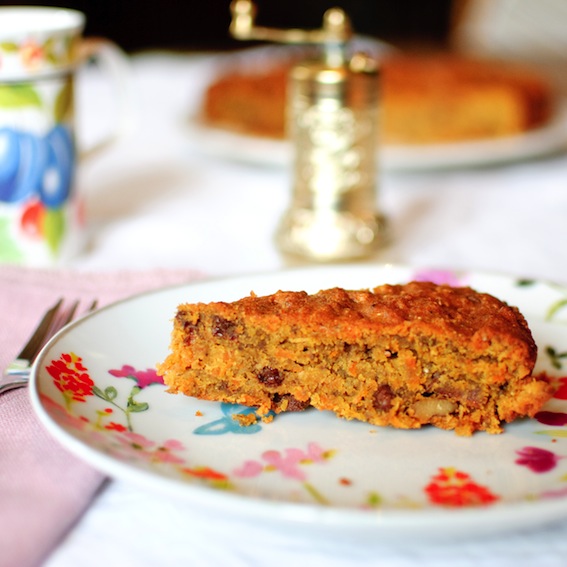
Word is out that I’m a bit of a rebel behind the wheel. Unfortunately I’m also married to, as my father puts it, a ‘repressed traffic warden’. He does have a point — how many people do you know that tell their guests to go and repark their cars within the confines of meticulously-placed traffic cones? (I blush to admit that we own traffic cones.) After our trip to San Sebastian, where I received more than one dressing-down for my mutinous driving, in particular U-turning, I’m now getting reflections from Léo’s friends. I drove one of them to his music lesson the other day and, in the time it took to drive about half a kilometre, he gleefully pointed out that I had entered the car park ‘the wrong way’, driven too close to the pavement and stopped in a disabled parking space. What can I say?
This carrot cake, although healthy and no-doubt sickeningly law-abiding, is deliciously moist and fragrant.
Ingredients
3 eggs
100g coconut sugar
2 teaspoons vanilla extract
200g ground almonds
100g dessicated coconut
2 teaspoons ground cinnamon
2 teaspoons freshly grated ginger
100g walnuts, roughly chopped
100g raisins
2 tablespoons rum
70g coconut butter, melted
70g butter, melted
200g carrots, grated
Preheat the oven to 140°C and prepare a 24cm cake tin. Place the raisins in a small saucepan and cook in the rum for about five minutes. Break the eggs into a mixing bowl, add the coconut sugar and vanilla extract and beat well. Add the ground almonds, coconut and spices, combining well. Stir in the melted butter and coconut oil, the walnuts and the raisin/rum mixture. Finally add the carrots and mix until everything is well combined. Transfer the mixture to the cake tin and cook for between 50 and 60 minutes (a fork should come out clean once cooked). -
Petits pots au chocolat (chocolate pots), abject terror and an egg dearth

Hugo’s in a bit of a bad place at the moment. He frequently wakes to the resonance of hunting rifles (beyond unsettling for a dog of his delicate mental constitution) and will only deign to go outside if accompanied. On Sunday morning, no doubt in his eternal quest for reassurance, I found him in bed with Léo. Needless to say, he had not been greeted with open arms.
Since the hens, although of sound mind, are enjoying a long sabbatical, I had to concoct an egg-free chocolate mousse solution. This is it:
Ingredients (makes 6 small pots)
150g organic dark chocolate (min 70% cocoa solids)
200ml coconut cream, chilled
20g salted butter
1 teaspoon rum (optional)
2 tablespoons agave syrup
5g agar agar
Whip the coconut cream well until it becomes fluffy. Break the chocolate into small pieces and melt it and the butter in a bain marie with the rum and agave syrup. Meanwhile, dissolve the agar agar in a small quantity of hot water (4 tablespoons), bring to the boil and simmer for a few minutes. Combine the whipped cream and chocolate mixture thoroughly. Then add the agar agar, mixing well. Transfer to small pots (or cups) and chill in the fridge for at least three hours before eating. -
Raw honey and learning when to stop talking

We went to a local Christmas market this weekend and, while I was busy buying my own bodyweight in locally-produced Landaise honey, Léo was busy consuming his bodyweight in garbure (a duck and vegetable soup typical of Southwestern France). The quantities of food that Léo consumes and the enthusiasm with which he does so, are becoming acute sources of embarrassment to me — you would honestly think that he wasn’t fed at home. Sometimes, for example, we drop into a local café at about 11am for a cup of coffee and he orders a three-course ‘menu du jour’. I desperately feel the need to justify his appetite and end up woefully tying myself in knots with comments like: ‘I do feed him at home you know! In fact I feed him extremely well!’. On realising that this sounds horribly pretentious, I might add: ‘When I say extremely well, obviously I mean, you know, normally. Well not out-of-a-packet normally, but, errr, very healthily’. Of course I end up sounding like a furiously back-pedalling crazy person who should probably learn when to shut up.
Anyway, back to honey. Honey has been used for its healing properties since biblical times when it was used, amongst other things, to treat diphtheria. Physicians of ancient times, such as Aristotle, Hippocrates and Cornelius made reference to its healing qualities. A recent Russian study showed that beekeepers in Georgia who consumed raw honey and pollen on a regular basis frequently lived to over 100, a few even living as old as 150.
Raw honey is honey that has not been heated, pasteurised or processed in any way. It is alkaline-forming and contains a multitude of vitamins, minerals, amino acids, enzymes and powerful antioxidants as well as other natural nutrients. It also contains the enzyme amylase, which aids in the digestion of starch. A piece of toast spread with honey, for example, is more easily digestible than a piece of toast without as the enzymes in the honey ‘predigest’ the starch. (Beware of pasturised honey, which is more or less equivalent to refined sugar.)
Raw honey has anti-viral, anti-bacterial and anti-fungal properties. It promotes general health as well as digestive health and also strengthens the immune system. It helps to control allergies and is an excellent remedy for skin wounds and all types of infections. It can also stabilise blood pressure, balance sugar levels, relieve pain, calm nerves and has been used to treat ulcers. It is an expectorant and has anti-inflammatory properties which means that it is useful in the treatment of respiratory conditions such as bronchitis and asthma.
The different varieties of honey have varying properties as well as quite distinctive aromas. Here are a few:
Acacia, a light and clear honey, is one of the most popular and sweetest honey varieties because of its mild delicate floral taste. Due to its low sucrose content, it is a good choice for diabetics. Acacia cleanses the liver, regulates the intestine, and has an anti-inflammatory action on the respiratory system.
Buckwheat honey is a dark, full-bodied and rich in iron. It contains a higher percentage of antioxidants than other honeys and is perhaps the strongest and darkest of all varieties.
Heather honey is thick, amber in color and has one of the strongest and most pungent flavours. It is fragrant and floral with a very lingering aftertaste that is almost bitter. Prized since ancient times due to its medicinal properties, heather honey is extremely high in protein.
Linden honey is pale yellow in colour with a distinctive yet delicate fresh woody scent. Due to its sedative quality, it is effective in the treatment of insomnia and anxiety. It may also be used to treat colds, coughs and bronchitis.
Pine Tree honey is not overly sweet, has a strong aroma and is rich in minerals and proteins.
Thyme honey’s healing benefits are second to none. It is currently being used in hospitals in France for its infection-fighting, powerful antioxidant properties. A 2009 Greek study found thyme honey to reduce the viability of both endometrial and prostrate cancer cells..
Wildflower honey can vary in colour from very light to dark its flavour ranges from light and fruity to tangy and rich, depending on the mix from the different seasonal wildflowers.
Raw honey should not be given to children under a year old as they lack the stomach acid to de-activate any bacteria. -
Plum honey cake and one-way city
We went to San Sebastian (Donostia) during the recent school holidays. San Sebastian, just over the border from France in Spain’s Basque country, is home to the first University of Gastronomy and boasts an exceptionally high concentration of Michelin-starred restaurants, as well as some of the best tapas — or pintxos — bars to be found.
We stayed in a hotel on one of the hills dominating the bay. The views from the balcony were absolutely stunning and this was, as I later found out, the best way to appreciate the town. I am no wimp when it comes to challenging city driving: I learned to drive in London and then for many years enjoyed regular and complicated tangos around the insane Arc de Triomphe ‘Etoile‘ roundabout with 70 other highly strung Parisians. But, after a number of near misses, San Sebastian’s complex one-way system got the better of me and I ended up conceding defeat. Léo took great delight in keeping a tally (with a rather abrasive running commentary) of my hugely illegal manoeuvres, details of which I would rather forget. And then, as if the stress at the idea of never ever being allowed to turn left again as long as I lived wasn’t enough, I got a call from home to say that Hugo had run away. More on that next time – my nerves are still in shreds! 😉
This cake is another little gem from Amber Rose’s book, ‘Love, Bake, Nourish’. The honey makes it deliciously, fragrantly soothing and I recommend you never drive anywhere without a large slice for arduous traffic situations.
Ingredients (serves 8)
180g spelt flour
2 teaspoons baking powder
130g ground almonds
½ teaspoon ground cinnamon
½ teaspoon ground cardamon
5 large free-range eggs
120g butter
120g organic coconut oil
180g honey
400g plums, stoned and quartered
Preheat the oven to 180°C and prepare a 22cm loose-bottomed cake tin. Mix the dry ingredients and set aside. In a separate bowl, beat the egg yolks, softened butter and coconut oil and honey until thick and smooth. Gently fold into the dry ingredients. Whisk the egg whites in a clean bowl until stiff and then fold into the mix making sure they are fully incorporated. Finally stir in the plums and transfer the mixture to the greased tin. Bake for 45 minutes or until a skewer poked into the centre comes out clean. Leave to cool before serving.
-
Guest post: Patient, heal thyself (part 3)
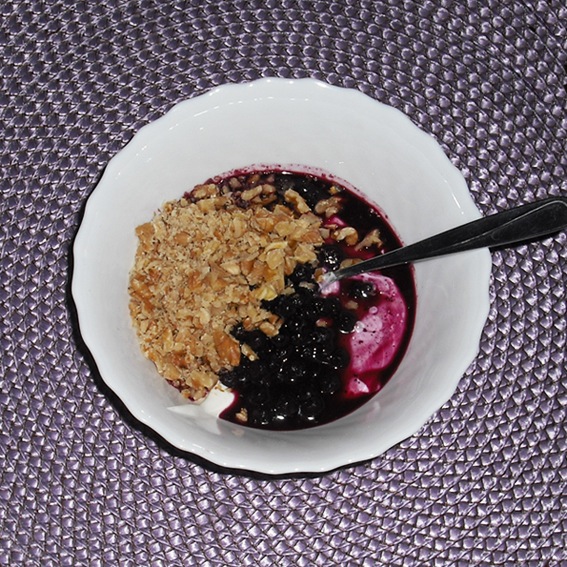
I had intended to continue sharing my recent benefits from switching in April to the ‘Eat Right 4 Your Blood Type’ plan, when last weekend put my intentions on hold. However, there was the added benefit of an experience important to all of us who need to watch what we eat, so I will share some of what occurred in this post.
While helping my partner erect an aluminum (aluminium, for those northwest of here) and plexi winter garden house, I suffered what appeared to be the beginnings of a heart attack. Germany has one very important aspect to their health care which I applaud: if the call is of a serious nature, an ambulance with a doctor on board is also dispatched to the scene. I won’t take you through the hooking up of a colourful assortment of tubes and such, and just say that after Mr. Toad’s Wild Ride through the German countryside, I arrived at a hospital with a highly-regarded cardio unit, where I spent several hours on monitors and bleeding into little glass tubes, on demand.
Upon determining that I was not in immediate danger, I was sent upstairs to a room, where they brought me the evening’s repast. Before continuing your digestion of this post, I suggest making certain that you are in a comfortable chair, as what I am about to share will stagger the imagination of most, and might even cause one to stagger in a literal sense. A caution has been made.
Dinner, for a person who has just arrived in the hospital’s cardio wing, and was under strict monitoring, was: two slices of bread, a slice of Emmentaler cheese (like Swiss cheese), three assorted slices of cold cuts, including salami, bologna and one that was unidentifiable, to me, and three tablespoons of watery yogurt. There were also two packets of mustard and a small cube of butter. No, I didn’t miss anything and I even looked under the tray, to be certain of this.
If you are a Type A person and you have already started the program, and know what the dos and don’ts are, you would recognize only the yogurt as being of any benefit, while the rest of the lot are absolute ‘don’ts.’ I mentioned this to the night nurse who remarked, ‘Everybody gets the same. No special treatment.’ Having passed two very elderly women in wheelchairs, as they were bringing me to my room, I wondered how they expected these two souls to be nurtured back to good health on such a meagre and very unhealthy diet.
Serving the least amount of food, with no regard to nutrition, is endemic in German hospitals and I have personally witnessed this in three other medical establishments. I have also asked physicians how they expect their patients to heal without proper nutrition, but they just shake their heads in a ‘it’s not my problem’ way. It is not a German attribute to rock the boat, so it is likely the insurance plan most patients are subscribed to determines costs for such things. It goes to prove the point that when bean-counters enter the picture, all compassion disappears. But, I digress.
Due to many issues, I had a sleepless night, one of which was being denied a sleeping pill, because, as the night nurse put it: ‘You are asking too late.’ Had I known my roommate could rattle the rafters with his snoring, I might have asked when I came to the room. But, unarmed with such important information, I was left without the necessary tool to overcome this obstacle and spent the night awake.
In the very early morning hours, nurses came to take blood and chose to poke a new hole in my other hand, although all previous blood samples had been taken from the hand with the nifty accoutrement that had been attached to me in the comfort of my best chair, the day before. Then, a young male nurse came to take my blood pressure, after which he presented a needle. When I asked what it was for, he told me it was to prevent thrombosis’ to which I replied: ‘No.’ I saw no need to have this additional toxin in my body, when I was still ambulatory and was not bedridden. He was perplexed, but he didn’t force the issue.
Later in the morning, one of the cardio doctors came to see me and spent some time telling me that I had not suffered a heart attack, stroke or anything severe enough to leave a telltale message in my system. The numbers they were giving me were the same as I had received from my cardio specialist, during my annual checkup in June, so I breathed a sigh of relief, and told her I wanted to go home. I was immediately counseled on the possible ‘consequences’ of such a decision, in view of their desire to keep me for observation and further tests, all of which I had experienced in June, and passed with flying colors. I then told her about my sleepless night, which seemed to go right past her, without reaction or comment.
The young doctor was adamant that I stay put, so I shared with her the details of my morning meal, which was: a slice of what looked like a mixed deli meat, two bread rolls, two packets of processed jelly, a cube of butter and three tablespoons of yogurt. I then continued with a description of the all important mid-day meal that had been brought to me, which was a vegetable consume, including remnants of carrots, potatoes and beans with a long, beef sausage placed in the middle of the bowl, a packet of mustard and two pieces of stale bread. After sharing these details with her, I told her about my eating plan and how it had cleared up two issues for me, which all of the ingredients the hospital had offered were sure to bring back to the fold. She shrugged in a kind of ‘what do you want me to do about it’ way, although I surmised that she was already thinking in her mind that there had to be some prescription that would do the trick rather well, in place of nutritious food.
When I asked her how she felt about serving the kind of food that was presented, to a person presumed to have a heart issue (after all, the did want to keep me for observation), she changed the topic back to the issue of ‘the possible consequences of going home.’
I thought about it and came to the realization that if I stayed there for the recommended period of time, taking the drugs they wanted me to ingest, in spite of showing no symptoms requiring drugs, and eating their food, I would have other serious issues returning to my life. I opted to leave, after telling her that I would much prefer to expire at home, eating healthy food, rather than in a hospital’s cold, dispassionate environment, while slowly being poisoned. She was not amused.
There were forms to fill out, more cautions expressed and then I was able to step outdoors, in the cool, dark afternoon, accompanied by my partner, who had brought one of our fun cars as a treat, in which to bring me home. The first breath of fresh air was rejuvenating and I continued to feel better during the ride home, in spite of my lack of sleep.
For that first meal upon my return to our home, I chose a breakfast meal of freshly chopped walnuts, Greek yogurt and blueberries. I also added a small dollop of maple syrup, which has been my sweetener of choice for more than thirty years. In the photo, you will see that I used frozen blueberries, as we are out of season for fresh, here, and I rather like having them year round. Frozen also allows me to vary the types of berries I use during the winter months, and allows me to thaw just what I need to avoid any spoilage, as well as providing a sugar-free juice from the thawing process.
I did see my GP this week and he reviewed the information about my adventure and came to the conclusion that, since this was a one-off event, that I should take it easy, lessen my work load some and give stressful situations a boot in the behind. I do have a tendency to work like I am still twenty-three, which is not to my benefit, now, and I had been overdoing it for a couple of weeks, even though I was experiencing a cold. My instinct tells me that it was just overloading the system with commitments and physical stress that caused my body to stop functioning at its optimum. When pressed for a reply, my GP begrudgingly admitted that leaving the hospital was a good idea, in this circumstance.
The point of sharing this experience is to demonstrate that in all cases, we will be responsible for our own health, even in an environment that is supposed to consider all aspects of our health its foremost concern. -
Plum and polenta cake and hawk-eyed osteopathic surgeons
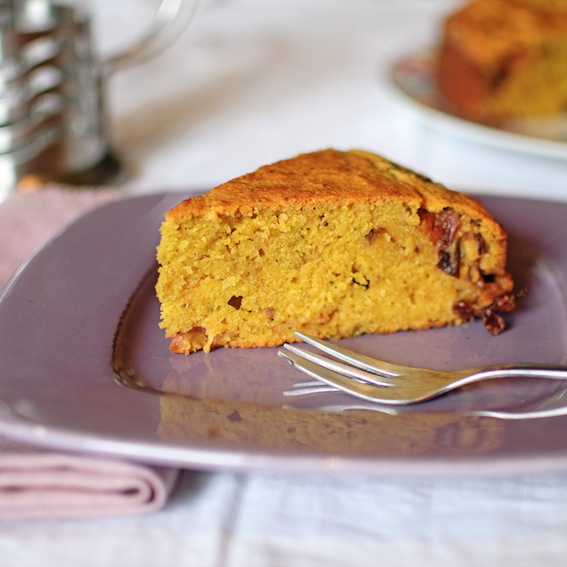
We went to hospital at the end of last week for a follow-up on Léo’s broken wrists. After the usual palaver of negotiating the maze-like corridors, locating the original x-rays (I now refuse to take responsibilty for images, having once turned up for a follow-up visit of my own armed with x-rays of my dog’s hip) and being on the receiving end of a particularly vicious swing door, we finally saw the surgeon who cheerfully proclaimed Léo’s right wrist to be healing beautifully. I assumed this meant that the left one wasn’t and anxiously enquired ‘and the left one?’ The doctor gave a classic double take and burst into peals of laughter saying ‘oh mon dieu! He broke BOTH wrists? How did he manage to do that? Who actually breaks both wrists at the same time?’ I had naively imagined that the fact that both wrists bore hefty casts might have been a clue as to the extent of his injuries, but apparently not. Tempted as I was to find out just how hilarious he would find a broken jaw, I resisted and, once again, poor Léo had to recount the story of the day he thought he could fly…
Ingredients
20g agave syrup
400g plums, pitted
130g ground almonds
150g spelt flour
150g polenta
1 teaspoon baking powder
pinch of salt
150ml honey
180g natural Greek yoghurt
4 large free-range eggs, beaten
180ml olive oil
Preheat the oven to 170°C. Put the plums and agave syrup into a saucepan and bring to a gentle boil, before lowering the heat and leaving to caramelise for a few minutes. Remove from heat and set aside. Blend the almonds, spelt flour, polenta, baking powder and salt in a bowl. In a separate bowl mix the eggs, honey, yoghurt and olive oil together well. Add the wet ingredients to the dry ingredients, folding thoroughly. Stir in the plums, transfer the mixture to a loose-bottomed cake tin and bake for 40 minutes. Leave to cool and serve.
